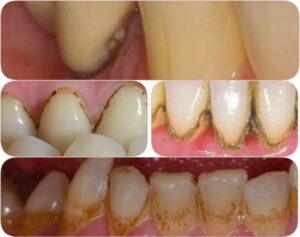Line On Tooth Causes Revealed

The appearance of a line on a tooth can be a cause for concern for many individuals, as it may indicate an underlying issue with the tooth’s health. There are several potential causes of a line on a tooth, ranging from harmless to more serious conditions. Understanding the possible reasons behind this phenomenon is essential for maintaining good oral health and addressing any problems promptly.
One of the most common causes of a line on a tooth is the presence of a crack or fracture. This can occur due to various factors, such as biting or chewing on hard objects, grinding or clenching the teeth, or even as a result of a traumatic injury to the mouth. If the crack is minor, it may not cause any symptoms, but deeper cracks can lead to sensitivity, pain, or even the loosening of the tooth.
Another possible cause of a line on a tooth is the development of a dental lesion or cavity. When bacteria in the mouth break down food particles, they produce acid, which can damage the enamel of the tooth and create a small pit or groove. If left untreated, this can progress into a full-blown cavity, potentially leading to more severe consequences, such as infection or tooth loss.
In some cases, a line on a tooth may be a sign of enamel hypoplasia, a condition characterized by the underdevelopment or incomplete formation of tooth enamel. This can be caused by genetic factors, nutritional deficiencies, or exposure to certain substances during tooth development. Enamel hypoplasia can make the teeth more susceptible to decay, sensitivity, and discoloration.
Other potential causes of a line on a tooth include:
- Dental fluorosis: a condition caused by excessive fluoride consumption during tooth development, leading to white or brown spots on the teeth.
- Enamel erosion: the wearing away of tooth enamel due to acid erosion, which can be caused by factors such as a diet high in acidic foods or drinks, gastroesophageal reflux disease (GERD), or eating disorders.
- Dental trauma: injury to the tooth or surrounding tissues, which can cause a range of symptoms, including a line or crack on the tooth.
- Tooth wear: the gradual wear and tear on the teeth due to factors such as grinding or clenching, which can lead to the formation of lines or grooves on the teeth.
It is essential to consult a dentist if you notice a line on your tooth, as they can assess the situation and provide a proper diagnosis and treatment plan. In some cases, the line may be purely cosmetic, but in other instances, it can be a sign of a more serious underlying issue.
Understanding the Importance of Prompt Dental Care
Prompt dental care is crucial for maintaining good oral health and addressing any issues related to a line on a tooth. Regular dental check-ups can help identify potential problems before they become more severe, and preventive measures, such as good oral hygiene practices and a balanced diet, can go a long way in reducing the risk of tooth decay, gum disease, and other oral health issues.
The Role of Diet and Nutrition in Oral Health
A well-balanced diet rich in essential nutrients, such as calcium, vitamin D, and phosphorus, is vital for maintaining strong teeth and bones. A diet high in sugary or acidic foods and drinks, on the other hand, can contribute to tooth decay, erosion, and other oral health problems. By making informed choices about your diet and lifestyle, you can reduce your risk of developing oral health issues and maintain a healthy, beautiful smile.
Advanced Dental Treatments for Tooth Lines
In cases where a line on a tooth is caused by a more serious underlying issue, such as a crack or cavity, advanced dental treatments may be necessary. These can include:
- Dental bonding: a procedure where a tooth-colored resin is applied to the tooth to repair a crack or chip.
- Porcelain veneers: thin, custom-made shells that are bonded to the front of the tooth to improve its appearance.
- Dental crowns: a cap that covers the entire tooth, used to restore its shape, size, and strength.
- Root canal therapy: a procedure where the infected pulp is removed, and the tooth is sealed to prevent further infection.
By seeking prompt dental care and maintaining good oral hygiene practices, you can reduce your risk of developing more severe oral health issues and keep your teeth strong and healthy for years to come.
What are the most common causes of a line on a tooth?
+The most common causes of a line on a tooth include cracks or fractures, dental lesions or cavities, enamel hypoplasia, dental fluorosis, enamel erosion, dental trauma, and tooth wear.
How can I prevent lines on my teeth?
+To prevent lines on your teeth, practice good oral hygiene, including regular brushing and flossing, and visit your dentist for regular check-ups. A balanced diet rich in essential nutrients can also help maintain strong teeth and bones.
What are the treatment options for a line on a tooth?
+Treatment options for a line on a tooth depend on the underlying cause and can include dental bonding, porcelain veneers, dental crowns, and root canal therapy. Your dentist can assess the situation and provide a proper diagnosis and treatment plan.
Can a line on a tooth be a sign of a more serious issue?
+Yes, a line on a tooth can be a sign of a more serious issue, such as a crack or fracture, dental lesion or cavity, or enamel hypoplasia. If you notice a line on your tooth, it is essential to consult a dentist for a proper diagnosis and treatment plan.
How often should I visit my dentist for check-ups?
+Regular dental check-ups are crucial for maintaining good oral health. The American Dental Association recommends visiting your dentist at least twice a year for routine check-ups and cleanings.

